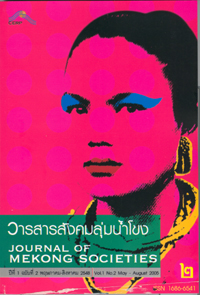A Politics of Remembrance: The Position of S. M. Ang Eng (1769-1796) in Cambodian History
Main Article Content
Abstract
This article addresses the way to approach Khmer puangsawada [Khmer chronicles]. Khmer historians may use a story about Cambodia in the 14th century in Khmer puangsawada to write history about the 14th century. On the other hand, they may use the same story in the same puangsawada to write a history of the 20th century, even though it is a story about the 14th century. This is because such historians donût use a text in the puangsawada to simply narrate; instead, they narrate history through studying the thoughts, value judgments, and so on, of the people and the time that produced the puangsawada. Consequently, puangsawada and historical writings are memoirs of remembrance of a people and their time. A different story about the same event can be narrated in puangsawada, and historical writings are an eyewitness remembrance of a different period. This paper concentrates on the position of S. M. Ang Eng (1769-1796) in Cambodian history. Puangsawada and historical writings that were composed in various times tell a different story about him. He is a predecessor of the present monarch of Cambodia, though the official succession traces royal ancestry back to S. M. Ang Daung (1847-1860), the youngest son of S. M. Ang Eng. By close reading and comparing between various puangsawada and historical writings, this paper reveals a remembrance of people and society from the mid 19th century until the present, rather than tells the true story of the late 18th century.


